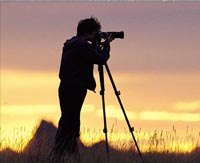|
Photographing and Viewing Wildlife
 View and photograph from established observation areas or the trail when hiking. If an animal approaches, back away in order to maintain a safe distance. View and photograph from established observation areas or the trail when hiking. If an animal approaches, back away in order to maintain a safe distance.
- Use binoculars, spotting scopes and telephoto lenses to view and photograph wild animals. This reduces stress on wildlife.
- Remain alert to potential danger while viewing or taking pictures.
- Avoid direct eye contact with bears, even through a lens, because it may be interrupted as a challenge or threat.
- Stay away from newborn or young animals, nest and dens.
- Never sneak up on or surprise an animal, especially a bear.
- Never try to get an animal to move to a different location.
- Allow other visitors to enjoy wildlife avoid blocking others' views.
- Watch other people in the area. Are they putting you in danger?
- Never surround, crowd, chase or follow an animal. It may respond by charging.
- Don't make sudden loud noises around wild animals.
Professional Photographers Get Great Photos by:
 Using appropriate telephoto lenses, and by cropping their photographs. Using appropriate telephoto lenses, and by cropping their photographs.
- Photographing in controlled wildlife management areas with special access permits.
- Being patient, practicing low-impact photography and devoting many years to getting desired photos.
- Using captive and conditioned animals at zoos and game farms.
Special Things to Know
- Startled bears will often confront intruders by turning sideways to appear larger, make woofing and teeth clacking sounds, salivating, laying their ears back and slapping the ground with their paws. These are warnings for you to leave the area.
- Mother bears are very protective of their cubs. A startled black bear will often send her cubs up a tree while she stands guard at the bottom. This gives you an opportunity to leave without a confrontation. Mother grizzly bears try to avoid people, but if you surprise one, she might bluff charge to remove the threat.
- Cougars are secretive and elusive. They can jump 30 feet from a standstill and 20 feet up a cliffside. They mark their territory by urinating on scratch piles usually made of grass, dirt, pine needles and leaves. They often hide behind bushes, logs or rock outcroppings, and usually leave an area when they hear people approaching.
- If a bear stands on its hind legs, it is not being aggressive. It is trying to see, hear and smell you better in order to identify what you are. Talk firmly and in a low-pitched voice while cautiously backing away.
- During extreme conditions such as droughts, thunderstorms and forest fires, all wildlife, especially bears and cougars, may become more aggressive and confrontational.
|